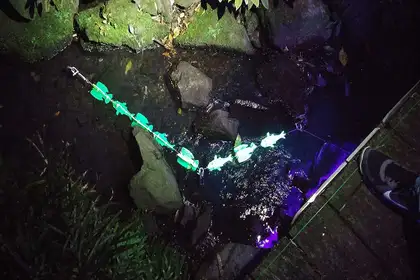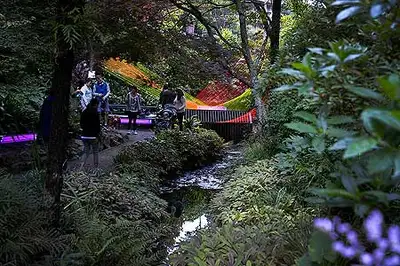
UV lit marine life created from aluminium tubing is part of summer night displays at Wellington Botanic Garden till January 29.
A tribute to the Kaikoura earthquake’s affect on marine life, made by Massey University design students, is among the creative works currently lighting up summer nights at Wellington’s Botanic Garden.
The students, based at the College of Creative Arts on the Wellington campus, have contributed three works to the Gardens Magic programme of events organised by Wellington City Council.
School of Design senior lecturer Antony Nevin set the challenge for students to build “creative and playful” responses to the Gardens event using light to engage the public.
One of the works titled Glowies is a tribute to marine life as well as people affected by the Kaikoura earthquakes. It uses a collection of ultra violet displays in the shape of crayfish and groper native to the region.

Geometric shapes set within the bush and stream environment are also part of the light displays.
Ruth Bai was one of a group of visual communication design students keen to acknowledge the disruption caused by coastal uplift in the earthquake that affected the habitat of various marine life forms.
“We wanted to memorialise the Kaikoura earthquakes in some way and acknowledge the impact of the coastal uplift on marine life like crayfish and paua,” she says.
Another installation titled Void, contrasts the garden’s bush and stream with softly glowing geometric shapes and optical illusions. Created by a team of four industrial design students, including Josh Bruderer, each cube features a tunnel of light that disappears into an abyss. The illusion is created by using a single strip of LEDs between a pair of mirrors.
“The intent behind the installation was to create something unexpected and mysterious as away to engage viewers,” Mr Bruderer says.
Mr Nevin described the collaboration with the council and lighting specialists from MJ Lighting as “ a way to see the city in a different light”.
Displays in previous years at the gardens including New Zealand Festival installations like Power Plant and city’s Lux Light Festival had helped students find inspiration for the design and type of reaction they hoped to draw from the audience, he says.